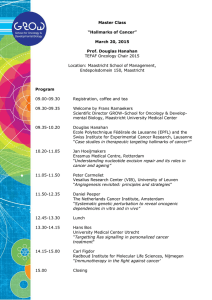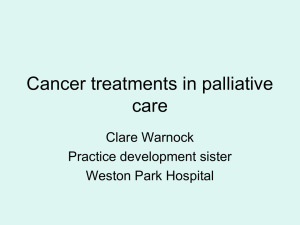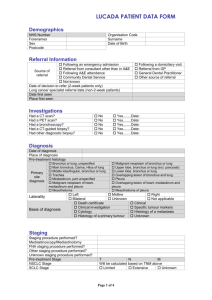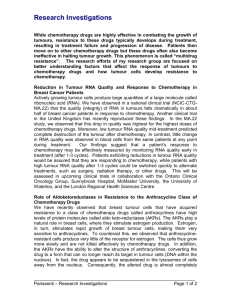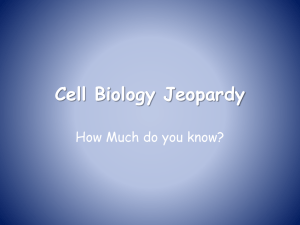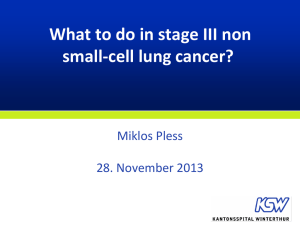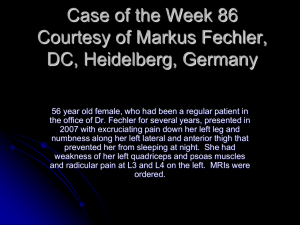Final_TumourBiology_Jan22
advertisement
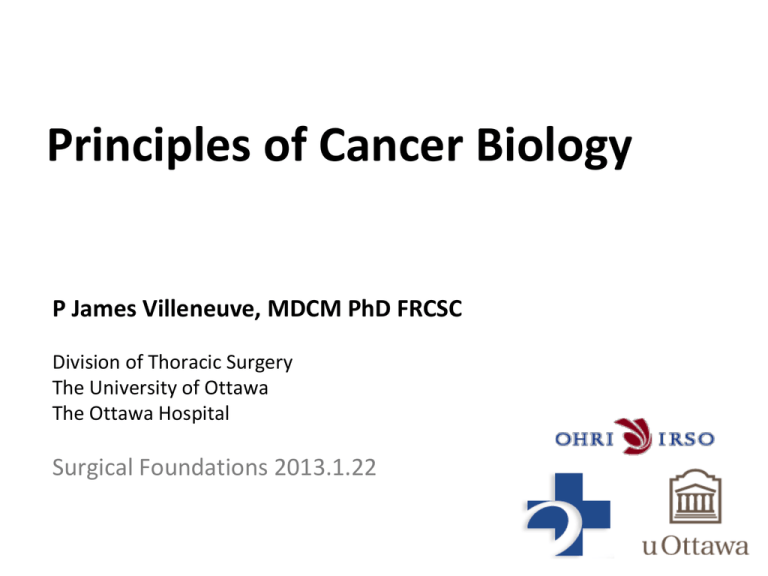
Principles of Cancer Biology P James Villeneuve, MDCM PhD FRCSC Division of Thoracic Surgery The University of Ottawa The Ottawa Hospital Surgical Foundations 2013.1.22 Outline • Basics – Cell cycle – Hallmarks of cancer – Metastasis • Radiotherapy – Mechanism • Chemotherapy – Mechanism • Surgical Oncology • Key points Tumourigenesis Loss of balance Oncogenes > Suppressors Principles of Cellular Growth • Ability to produce exact replica – essential component of life • Normal cellular regulation – Balance between division and death (apoptosis) – Limits on proliferation • Physical boundaries (e.g. basement membrane) • Tissue pressure contact inhibition – Cell cycle regulation • Error correction – – – – Lack of fidelity in cellular reproduction genetic instability Repair genes Immune mechanisms: removal of non-self cells Apoptosis Cell Cycle • Organized unidirectional process to achieve identical cellular replicas – Compare to meiosis • Mitosis – Process of chromosomal segregation and cytoplamic division • Interphase – Growth (gap) phases G1, G2 [G0] – Synthesis phase Spindle: Chromosomes aligned G2/M: full, accurate DNA replication G1/S: adequate cellular growth to support replication http://www.genome.jp/kegg/pathway/hsa/hsa04110.html Oncogenes : Oncoproteins • Genetic sequence (gene) that causes cancer – Huebner and Todaro (1969) • First described Src – Chicken virus causing sarcomas – Martin (1970) • Proto-oncogene – Arising from mutations, increased expression, translocations – Bishop and Varmus (1967): Nobel Prize 1989 • RAS, WNT, MYC, ERK, TRK, Ph’ What is cancer then? • Balance between oncogenic stimulus and tumuor suppressor activity • Tumours are characterized by – 2 cell populations • Actively dividing : Quiescent – Growth fraction • Proportion in active division and proliferation – Growth rate • Fraction dividing • Rate of division • Rate of attrition Tumour cell kinetics and you • 1cm3 = 1g tumor ( 109) cells – 1 cm the limit of clinical detection – 30 doublings occurred prior to clinical detection • Only 10 more doublings (3 logs) – 1kg of tumor – terminal disease • 75% of tumour growth occurs prior to clinical detection 30 doubling times Lethal tumour burden (1000g) Hoeijmakers J (2009) NEJM 361:1475-85 Vogelstein, Science (1991) Gastroenterology (2010) 138(6)2101-14 Hanahan, Weinberg (2011) Cell 144:646-74 Hanahan, Weinberg (2011) Cell 144:646-74 The microenvironment is important Hanahan, Coussens (2011) Cell 144:646-74 Hanahan, Coussens (2011) Cell 144:646-74 Hoeijmakers J (2009) NEJM 361:1475-85 Radiotherapy Surgery by non-surgical means Medscape Mechanism of action • Ionizing radiation – Photon (gamma ray) – Beta particle (electron) – Alpha particle • Mechanistically, based on tissue-particle interactions – Photoelectric effect – Compton effect • Depth-energy-particle type dependence Delivery methods • External beam – Most common – Radiation source is at distance from patient • Brachytherapy – Radiation source is close or within tissue being treated Deliver higher doses Prevent tissue damage Greater kill due to redistribution of tumour Medscape Predicting tissue response Repairable damage Irreparable damage Medscape Chemotherapy Whole-body therapy Principles of Chemotherapy • Exponential relationship between dose and kill – small decrease in drug dose results in large increase in cell survival • Cycling cells at greatest risk • Multiple courses of therapy – each treatment kills same proportion (not number) of cells – e.g.: 3 log killed 1010 to 107 1 log regrowth between cycles Classes of chemotherapy agents • Based on cell cycle • Phase-specifc – Exhibit a dose-plateau • Phase insensitive – Linear kill kinetics Phase insensitive • Alkylating agents – Platinums – Mustards • Typically have severe side effects – Bone marrow depression – Emetogenic Phase-sensitive agents • S-phase drugs interfere with nucelotide synthesis – ‘false’ nucleotides – Cofactor antimetabolites • M-phase drugs interfere with chromosomal segregation – Microtubule inhibitors • G1/G2 phase agents intefere with basal cellular machinery Cancer surgery Cures most solid tumors Surgery : Chemo : Radiotherapy • Surgery is mostly oncology • Timing of treatment – Neoadjuvant • Precedes surgical intervention • Aims to improve margins, decrease metabolic burden – Adjuvant • Follows resection • For nodal disease Surgical Oncology Terms • R = residual – R0 = complete resection – R1 = margins are microscopically positive – R2 = margins are grossly positive • Stage and groupings – Based mostly on TNM classification – Stages are aggregates of TNM variables Key points • Cancer arises from – Mutations – Cause dysregulation in key cellular functions – Oncogenes : suppressors • Presentation of cancer – – – – Depends on tumour burden Depends on kinetics Metastasis Microenvironment Key points (2) • Radiotherapy – DNA damage and ROS – Ionizing energy – Damages normal tissues • Chemotherapy – Depends on agent used – Selective action on more rapidly dividing cells Key points (3) • Diagnosis and staging lead to treatment • Understanding the concepts of tumourigenesis will help understand the approach to cancer care Questions?
